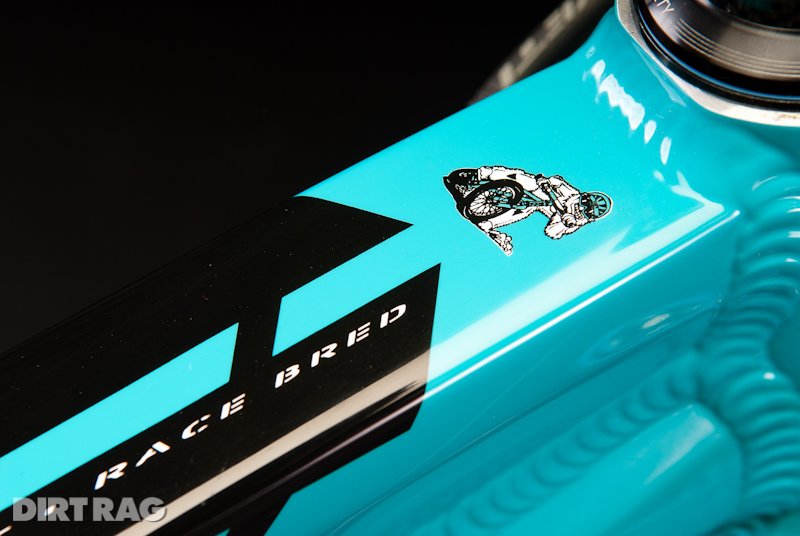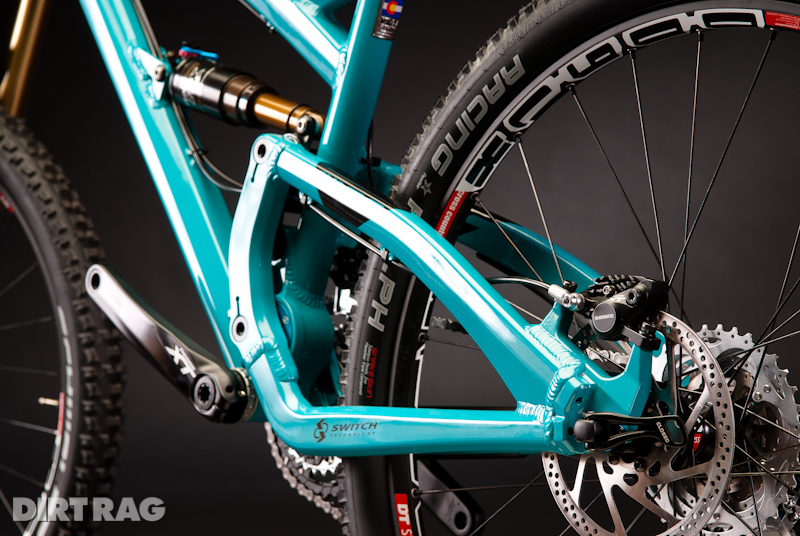Review: Yeti SB-66
Originally posted on October 9, 2013 at 20:57 pm
By Justin Steiner
There’s been much hubbub in recent months about Yeti’s newest flag- ship trail bike, the SB-66. At first glance, it seemed strange that Yeti might keep their venerable 575 alongside this new 152mm-travel machine, given their similar geometries and travel figures. Yeti’s Chris Conroy described the differences and the reasons for having both bikes in the Yeti lineup: “The 575 is plusher, the SB-66 will feel more ‘performance.’ Those are subjective descriptions, but the SB-66 will pedal better than the 575. Riders interested in comfort and being able to blast through rock gardens with a more muted feel would prefer the 575. On the SB-66 you will feel the nuances of the trail more.”
Having reviewed, and thoroughly enjoyed, the 575 in issue #154, I was eager to experience the differences for myself.

The SB-66 utilizes the patented Switch suspension design, which Yeti has licensed from the Sotto Group. The Switch system consists of an eccentric main pivot that rotates counterclockwise during the first two-thirds of the suspension’s stroke, then “switches” to rotate clockwise after the inflection point. When putting power through the pedals, chain tension resists the eccentric’s rearward motion, providing a healthy dose of anti-squat. After the inflection point, where the eccentric begins rotating the opposite direction, suspension action is largely independent of drivetrain forces for a plush end of stroke.
In terms of frame construction, the SB-66 offers all of the latest standards: tapered head tube, 142x12mm rear axle, cable guides for a dropper post, and an ingenious splined BB interface that accommodates a removable ISCG mount. This frame is beautifully designed and constructed, presenting a very lust-worthy package in Yeti’s signature turquoise color. Yeti’s execution of the Switch suspension design is also beautifully manufactured: a one-piece, forged bottom bracket assembly houses both the eccentric assembly and the upper link’s pivot to maximize stiffness. The rubber bumpers on the top and bottom of the chainstays are also a nice touch.
The SB-66 continues Yeti’s characteristically slack and low geometry with a 67 degrees head tube angle (one-degree slacker than the 575) and a 13.5-inch unsagged BB height (interestingly, two tenths of an inch higher than the 575). These numbers are quickly becoming status quo for this type of bike.

Yeti designed the SB-66 with longer-than-average top tubes, which extend the bike’s front-center to add a bit of stability. Cockpit length is maintained by running short stems—in the 50-70mm range. At 5’7”, I’m right on the cusp between small and medium sizes. Conroy recommended I ride a medium with a shorter stem; however, a size small was delivered for testing. I subsequently ran a 90mm stem and a wider-than-stock 750mm handlebar to attain my desired fit, which generally requires a larger-than- normal bike.
Having come off a host of 150-160mm test bikes, I was immediately struck by just how efficient the SB-66 is when pedaling, regardless of whether you’re seated or standing. This bike pedals unbelievably well considering its 152mm of travel; mash the pedals and the suspension barely moves a wink. This responsive pedaling performance lends an air of XC-ish-ness to the suspension feel of this trail bike—it pedals more like a 120mm-travel bike than a 150mm bike. As Conroy indicated, the SB-66 isn’t necessarily a plush ride, but it is lively while retaining its ability to comfortably absorb large hits.
The stellar pedaling performance combined the bike’s low and slack geometry makes for a potent backcountry package. The SB-66 is truly a bike you can pedal all day while hitting nasty technical terrain and high-speed sections with confidence and control.

As you might expect, the SB-66 feels great at speed and absolutely loves being cranked over into corners. The handling feel is best described as balanced, with good stability when you need it, yet offering plenty of maneuverability thanks to reasonable 434mm chainstays and the firm suspension feel.
This frame is burly and stiff, easily overpowering the stock Fox 32 150mm fork and DT Swiss X1600 28-spoke wheels on my test bike. Those parts, along with the XT drivetrain and brakes, represent the light end of the SB-66 build kit, which is perfectly suited for those looking for a long-legged, XC-oriented trail bike. On the other end of the spectrum, the Enduro 36 build kit with a Fox 36 fork and burlier DT Swiss wheels (350 hubs and E530 rims) will better match the frame’s stiffness over rough terrain and would be a better choice for more punishing riders. Build kits will remain largely the same for 2013, with the addition of 34mm fork options.
One point worth mentioning: the SB-66 has a slack seat tube—72 degrees with a 32mm-chassis fork, 71 degrees with a 36mm-chassis fork. This arrangement will work for the majority of riders, but those with short femurs may struggle to achieve their preferred pedaling position. I had my seat slammed forward with the zero-offset seatpost.

I’m extremely impressed by the SB-66’s ability to deliver such stellar performance over a broad spectrum of applications while making no major concessions. It’s efficient and downright snappy, but offers big-hit capability that’ll tackle most anything short of a bike park. The chassis is stout. It’s slack and low, but never feels sluggish since you’re often carrying more speed than you would on a steeper bike.
Compared to Yeti’s 575, the SB-66 feels much more lively. It feels like it rides a bit higher in its travel most of the time. Where the 575 felt like it delivered more than its numeric travel due to the suspension’s plushness, the SB-66 tends to feel like a shorter-travel bike due to its stellar pedaling performance and snappy suspension feel.
If I was forced to choose just one bike, the SB-66 with the Race 36 build kit might just be it—with the addition of a dropper post, of course. Equipped as such, you’d rarely feel under- or over-gunned, from epic backcountry adventures to epic shuttle runs. There are bikes better suited to either end of that spectrum, but few, if any, cover as much ground with such few compromises as the SB-66.

Vital stats
- Wheelbase: 44.2-inches/1,123mm
- Head Angle: 67 degrees
- Seat Tube Angle: 72 degrees
- Bottom Bracket: 13.5-inches/343mm
- Chainstay Length: 17.1-inches/434mm
- Weight: 28lbs./12.7kg
- Sizes: S (tested), M, L, XL
- Price: $4,500
- Made in Taiwan
- Online: yeticycles.com